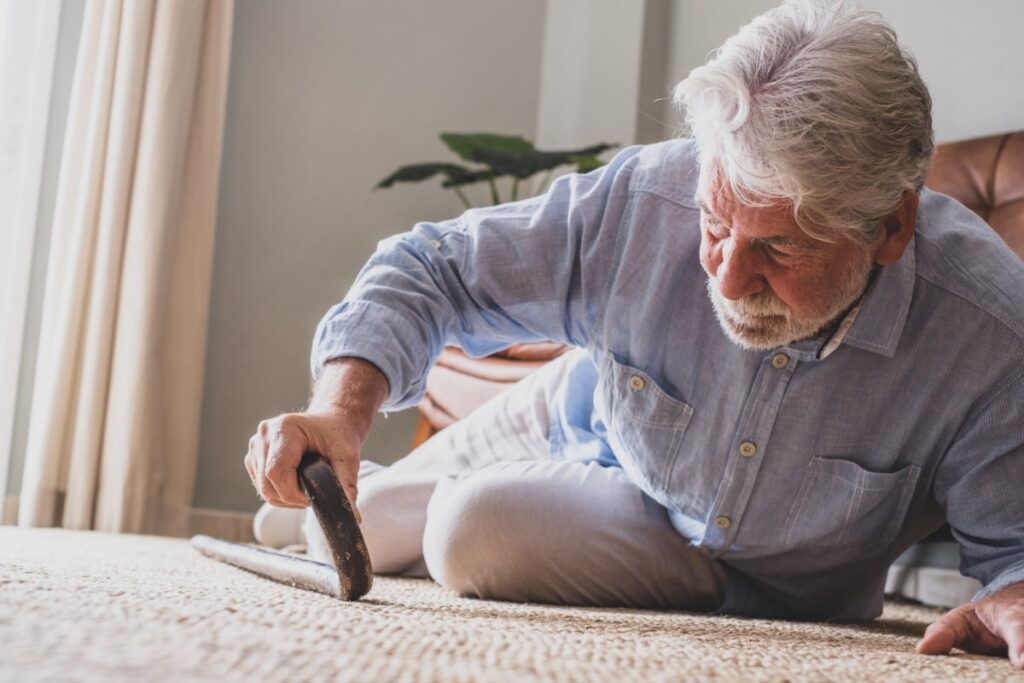Table of Contents
One of the things I check with both new and existing patients is if they know how to get up from a fall. I ask them when was the last time that they practiced lowering themselves to the floor and then getting back up. Getting on and off the floor is an important part of an overall fall prevention assessment. I am not surprised when clients hesitate to tell me that it has been a long time since they practiced how to get up after a fall.
I have a large, dense one-inch foam mat that we use to explore best options for getting down and back up. We practice the two technique I present in the video below and describe in this blog.
If you are someone who does not have a strategy for getting up from the floor, I encourage you to watch this video and read this blog. Having a strategy is good, but practicing your strategy on a regular basis allows it to become instinctive. Knowing that you are able to get up from the floor removes some of the fear of falling.
I hope that you use and practice one of these techniques. Please do not practice these alone if you are not certain that you can get up and down successfully. Wait until you have a family member with you or you book time to work with a Physical Therapist who can assist you to in finding the best strategy for you.
How to Get Up After a Fall • A Case Study
If you are a regular reader of this blog, you may recall my client, Babs, who is featured in earlier blog posts on balance. One of her weekly exercises was to get down to the floor, practice a few feet of crawling forwards, get down onto her tummy, do a few knee bends or some other exercise, press back to her hands and knees and crawl backwards to get up again.
On days that she did not have the energy or we ran out of time, we simply practiced crawling forwards and backwards from the foot of her bed. Crawling on her knuckles to make it easier on her wrists.
Shortly after her 96th birthday, I showed up for one of her weekly therapy sessions. I asked her if she had had a good night of sleep. She told me she had fallen during the night while returning from the bathroom but that she remembered our practice sessions and had crawled back into bed. She was proud that she had not spent the night on a cold floor. All her practice on how to get up after a fall had payed off.
Time flies and so be sure to include getting down and up from the floor on a regular basis. You want your technique to become so instinctive that you can just get on with life the way Babs did.

Balance and Fall Prevention
You are all aware, have read and heard numerous times that you will reduce your risk of falling if you improve your balance and are aware of fall prevention strategies.
However, falls do happen. The World Health Organization (WHO) estimates that 646,000 individuals worldwide die each year from falls and that falls are the second leading cause of accidental injury deaths. (1)
Like Babs getting up at night with the lights low is a common cause of falling. Other common causes of falls include catching your toe on a curb, missing a step, slipping on ice, or losing your footing.
Hopefully, you have practiced and you know how to get up from a fall. Even if you have not injured yourself physically, falling can injure your self-esteem and your pride. Being able to get up from a fall restores your pride. Not knowing how to get up can cause panic to set in and make matters worse.
Here are two different strategies you can practice at home. The detailed steps for each strategy that can help you get up after a fall are outlined below.
How to Get up From a Fall Using an Elevated Surface for Support
Roll onto your uninjured side after the fall.
If you have not injured your upper body choose the stronger arm or uninjured leg side. Alternatively, if you are able to get onto your hands and knees, crawl to a sturdy elevated surface such as a bed or chair.
Elevate yourself onto one forearm by pushing up with the arm on the top side and use the bottom arm to support you, once you have lifted your torso.
Move Towards a Chair (or Other Sturdy Elevated Surface)
- At this point, drag your body across the floor on one forearm. This requires some strength. As a result, I encourage you to build your strength with side planks from a lying position. You could practice this press action on the floor or on a firm bed.
- Take a moment to look around and choose the closest sturdy surface.
- Drag yourself by alternating between pulling your knees then your forearm towards your destination.
- To move forward, bring your knees up.
- Use the strength of your legs to push or pull yourself along the floor as you make your way.
- When you get to your destination (a bed or chair, for example), rest your head, catch your breath and gather your energy for the next part.
- Get in close to the chair.
- Use your arm to lift your torso up so that you can rest your arm on the chair.
- Take as many pauses as you need.
From this position, you have two options.
Option 1 • How to Get Up From a Fall
In the first option, put most of the weight on your unaffected side, or the happier side, and lift yourself so that both arms and your upper body are resting on the chair. At this point do the following:
- Use your good (pain free) side as your power side for arm support.
- Use the leg on the opposite side as your power leg.
- I suggest you transfer some of the weight forward. Push up through your arm and push down through your foot.
- As soon as you can clear the chair, pivot over into the chair.
- In the video, I cleared it a lot more than you actually would need to.
Option 2 • How to Get Up From a Fall
Consider option two on how to get up from a fall if you make it to the chair and you know you do not have have the strength in the supporting knee and one shoulder to execute the lift and pivot. In this instance follow these steps
- Face the chair, rest both forearms on the chair.
- Transfer weight into your forearms or onto your hands (if you have not injured your wrist).
- Press firmly into the chair or bed.
- Bring one foot back and then the other foot back. Keep your feet hip width apart for more stability.
- Walk around far enough that you can then pivot your butt onto the chair.
- Alternatively, you can bring your hands to your thighs and walk your hands up your thighs until you come to standing.
Exercise Recommendations for Osteoporosis
Exercise is an essential ingredient to bone health. If you have osteoporosis, therapeutic exercise needs to be part of your osteoporosis treatment program.
But what exercises should you do and which ones should you avoid? What exercises build bone and which ones reduce your chance of a fracture? Is Yoga good for your bones? Who should you trust when it comes to exercises for osteoporosis?
A great resource on exercise and osteoporosis is my free, seven day email course called Exercise Recommendations for Osteoporosis. After you provide your email address, you will receive seven consecutive online educational videos on bone health — one lesson each day. You can look at the videos at anytime and as often as you like.

I cover important topics related to osteoporosis exercise including:
- Can exercise reverse osteoporosis?
- Stop the stoop — how to avoid kyphosis and rounded shoulders.
- Key components of an osteoporosis exercise program.
- Key principles of bone building.
- Exercises you should avoid if you have osteoporosis.
- Yoga and osteoporosis — should you practice yoga if you have osteoporosis?
- Core strength and osteoporosis — why is core strength important if you have osteoporosis?
Enter your email address and I will start you on this free course. I do not SPAM or share your email address (or any information) with third parties. You can unsubscribe from my mail list at any time.
How to Get up From a Fall With No Elevated Surface For Support
I frequently teach my clients this second technique on how to get up from a fall. Clients that regularly exercise on the ground find it easy to do on a day-to-day basis.
Test Your Flexibility
You need to be somewhat flexible to do this technique. Here is how to test if you are flexible enough.
- Lie on your back.
- Lift your leg up.
- If you are able to comfortably lift both legs close to 90 degrees, say between 75 and 90 degrees, then this technique is a real viable option for you to use.
How to Get Up From a Fall Technique
- Go flat on your hands or your knuckles — whichever is more comfortable for you.
- If you have fallen and landed on your shoulder, roll onto your stomach.
- From here, tighten up your tummy muscles and push back.
- Get your butt up in the air behind you.
- Push back through your forearms with your butt up.
- At this point, widen the space between your knees and keep the feet the same width as your knees.
- Push up onto your knuckles or onto flat hands — depending on your wrists and your hands.
- Your toes will have to tuck under.
- Press and walk your hands back towards your feet.
- As soon as you can get your forearms onto your thighs do so and rest for a moment.
- Bring your hands to your thighs and rest for a moment (it will look like you are in a baseball shortstop posture).
- Finally, walk your hands up your thighs until you come to standing.
If you found that this technique worked well for you, practice it every day. Come down into the shortstop position and then come down onto the ground. From here, come straight down onto your tummy, keep your tummy muscles nice and tight as you do so.
This is certainly a great and a safe alternative to get up from a fall.
Conclusion
We all have very unique bodies and medical histories including numerous aches and pains, arthritic joints and joint replacements. If neither of these strategies on how to get up after a fall worked for you, I encourage you to find a physical therapist near you who can help you work through your unique challenges.
Build your confidence getting up and down from the floor. This will help you feel you know how to get up after a fall and, in turn, reduce your fear of falling.
References
- Falls. World Health Organization. https://www.who.int/news-room/fact-sheets/detail/falls
Balance Exercises for Seniors Guidelines
For more information, check out my Balance Exercises for Seniors guidelines.

Comments